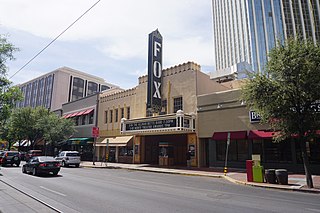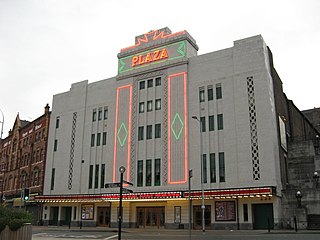
The Castro Theatre is a historic movie palace in the Castro District of San Francisco, California. The venue became San Francisco Historic Landmark #100 in September 1976. Located at 429 Castro Street, it was built in 1922 with a California Churrigueresque façade that pays homage—in its great arched central window surmounted by a scrolling pediment framing a niche—to the basilica of Mission Dolores nearby. Its designer, Timothy L. Pflueger, also designed Oakland's Paramount Theater and other movie theaters in California during that period. The theater has more than 1,400 seats.

The Tennessee Theatre is a movie palace in downtown Knoxville, Tennessee. The theater was built in 1928 in the 1908 Burwell Building, considered Knoxville's first skyscraper. The theater and Burwell Building were added to the National Register of Historic Places in 1982, and the theater was extensively restored in the early 2000s. The Tennessee Theatre currently focuses on hosting performing arts events and classic films, and is home to the Knoxville Opera and the Knoxville Symphony Orchestra. The theater is managed by AC Entertainment.

The Tampa Theatre is a historic U.S. theater and city landmark in Downtown Tampa, Florida. Designed as an atmospheric theatre-style movie palace by architect John Eberson, it opened on October 15, 1926. The theatre features a wide range of independent, foreign, and documentary films. It is Tampa's only non-profit movie palace, and operating costs are supported by its members, donors, and corporate sponsors, as well as by ticket and concessions sales. It has often been used as a backdrop for movies, music videos, and local programming.

The Alabama Theatre is a movie palace in Birmingham, Alabama. It was built in 1927 by Paramount's Publix Theatres chain as its flagship theater for the southeastern region of the United States. Seating 2,500 people at the time, it was the largest in the Birmingham theater district. The district was once home to many large theaters and movie palaces that featured vaudeville, performing arts, nickelodeons and Hollywood films. Built to show silent films, the Alabama still features its original Wurlitzer theater organ. The Alabama Theatre and Lyric Theatre are the district's only remaining theaters, and as of 2024, both are in operation.
The Blue Mouse Theatre title was used for several historic vaudeville and movie venues opened by John Hamrick in the Pacific Northwest of the United States. The name may have been inspired by a lounge in Paris. Hamrick is said to have used the colored rodential title for his first theatre in each city.

Shea's Performing Arts Center is a theater for touring Broadway musicals and special events in Buffalo, New York. Originally called Shea's Buffalo, it was opened in 1926 to show silent movies. It took one year to build the entire theatre. Shea's boasts one of the few theater organs in the US that is still in operation in the theater for which it was designed.

The Chicago Theatre, originally known as the Balaban and Katz Chicago Theatre, is a landmark theater located on North State Street in the Loop area of Chicago, Illinois. Built in 1921, the Chicago Theatre was the flagship for the Balaban and Katz (B&K) group of theaters run by A. J. Balaban, his brother Barney Balaban and partner Sam Katz. Along with the other B&K theaters, from 1925 to 1945 the Chicago Theatre was a dominant movie theater enterprise. Currently, Madison Square Garden, Inc. owns and operates the Chicago Theatre as a 3600 seat performing arts venue for stage plays, magic shows, comedy, speeches, sporting events and popular music concerts.

Peery's Egyptian Theater is a movie palace located in Ogden, Utah, United States. It was added to the National Register of Historic Places in 1978.

The Gillioz Theatre is a historic theater located at Springfield, Missouri, United States. It was built by M. E. Gillioz of Monett, Missouri. Mr. Gillioz was in the business of building bridges, and the theater was built with steel and concrete. Wood was only used for handrails, doors, and doorframes. The original cost of the building was $300,000. Renovation costs totaled approximately $1.9 million.

The Paramount Theatre is a 1,693-seat theater in Cedar Rapids, Iowa. It was individually listed on the National Register of Historic Places in 1976. In 2015 it was included as a contributing property in the Cedar Rapids Central Business District Commercial Historic District.

The Orpheum Theatre, a 2,308-seat venue listed on the National Register of Historic Places, is located in downtown Memphis, Tennessee, on the southwest corner of the intersection of South Main and Beale streets. The Orpheum, along with the Halloran Centre for Performing Arts & Education, compose the Orpheum Theatre Group, a community-supported nonprofit corporation that operates and maintains the venues and presents education programs.

The Fox Tucson Theatre is located in downtown Tucson, Arizona, United States. The theater opened on April 11, 1930 as a performance space in downtown Tucson. It hosts a wide spectrum of events and concerts featuring a variety of performing talent, ranging from ballets, to jazz, contemporary pop, world music and rock acts.

The Riviera Theatre is a historic, 1140 seat entertainment venue in North Tonawanda, New York. The theatre hosts live concerts, theatre, dance shows, and movies. The Riviera's “Mighty Wurlitzer” theatre organ has been restored, is maintained by volunteers, and is famed as being one of two original Wurlitzer demonstrator organs, which the company would use to show off to potential clients in the height of the silent film era.

An atmospheric theatre is a type of movie palace design which was popular in the late 1920s. Atmospheric theatres were designed and decorated to evoke the feeling of a particular time and place for patrons, through the use of projectors, architectural elements and ornamentation that evoked a sense of being outdoors. This was intended to make the patron a more active participant in the setting.
The Shoppes at Solana is a shopping mall in El Paso, Texas, owned and operated by Enoch Kimmelman. It is located on El Paso's west side, at Interstate 10 and Sunland Park Drive. It features five anchor stores operating under four brand names, and more than 130 specialty stores on two enclosed levels. It is the second-largest mall of the three in the metro area, behind Cielo Vista Mall.

The Stanford Theatre is a classical independent movie theater in Palo Alto, California. It was designed and built in the 1920s as a movie palace styled in neoclassical Persian and Moorish architecture. Today it specializes in films produced between 1910 and 1970 and seasonal programs typically include film festivals for various genres, directors, and actors, such as Alfred Hitchcock, Bette Davis, and Cary Grant. The Stanford Theatre frequently accounts for as much as twenty-five percent of all classic film attendance in the United States.

The Plaza is a Grade II* listed art deco single-screen cinema and theatre in Stockport, Greater Manchester, England. It opened in 1932, its construction having involved the excavation of the sandstone cliff behind it. After an initial closure in 1966 and a subsequent period in use as a bingo hall by Rank Leiure, it has now been restored as a cinema and theatre, showing films and staging live shows.
Walt Strony is an American recording, consulting and performing organist and organ teacher, both on the theatre organ and traditional pipe organ, ranging from pizza parlors to churches and theatres to symphony orchestras.

The Tivoli Theatre, also known as the Tivoli and the "Jewel of the South", is a historic theatre in Chattanooga, Tennessee, that opened on March 19, 1921. Built between 1919 and 1921 at a cost of $750,000, designed by famed Chicago-based architectural firm Rapp and Rapp and well-known Chattanooga architect Reuben H. Hunt, and constructed by the John Parks Company, the theatre was one of the first air-conditioned public buildings in the United States. The theatre was named Tivoli after Tivoli, Italy, has cream tiles and beige terra-cotta bricks, has a large red, black, and white marquee with 1,000 chaser lights, and has a large black neon sign that displays TIVOLI with still more chaser lights.

The Stavros Niarchos Foundation Parkway, or simply the Parkway, is a movie theater located at 5 West North Avenue in Baltimore, Maryland. The Parkway is open as of May 3, 2017, and is the new permanent home of MdFF. The Maryland Film Festival, a 5-day annual festival created and operated by MdFF, is housed in and around the Parkway and throughout the Station North Arts and Entertainment District.
























